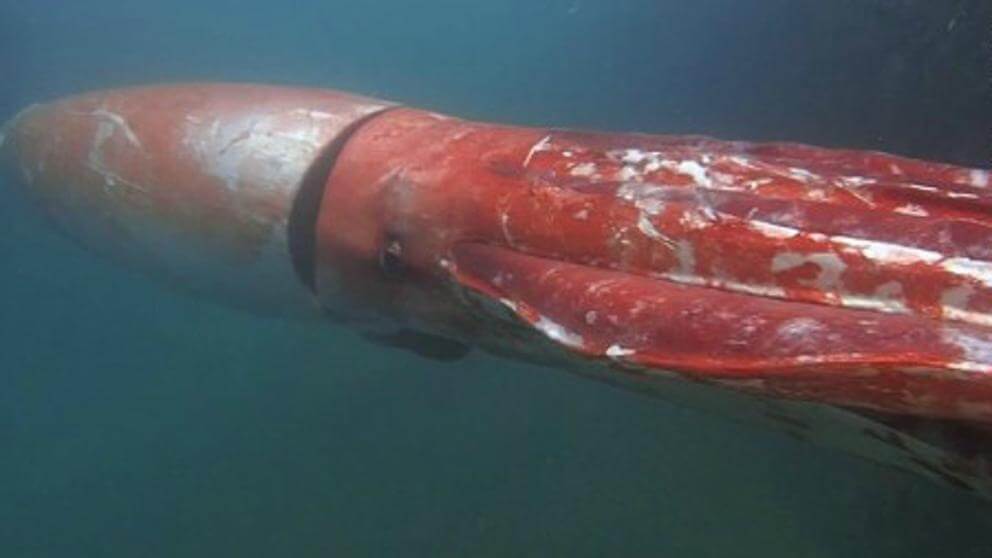9 Curiosities About the Giant Squid

Aquatic animals can range from being just an inch or two long up to nearly 100 feet. This characteristic has led to many different myths about these creatures, and many believe that even larger species may exist. In this article, we’ll be focusing on the amazing giant squid!
These enormous cephalopods belong to the genus Architeuthis, and their tentacles can reach up to almost 18 meters (60 feet) long. Continue reading and discover several curiosities about the giant squid.
Interesting curiosities about the giant squid
Apart from its immense size, this species has plenty of other secrets behind its enigmatic appearance. Listed below are the 9 most incredible curiosities about this animal.
1. The Kraken was based on this species
Surely you’ve heard the incredible story of a squid-like sea monster that inhabits the depths of the ocean. This being was feared by sailors, as it was thought to rise to the surface from time to time and was capable of sinking a ship with its powerful tentacles.

Although little is known about the true identity of the Kraken, it’s now believed that the only species that could fit the traits described in the myth is Architeuthis dux. Of course, it’s unlikely to be capable of sinking a ship with its tentacles alone, but in ancient times there may possibly have been even larger specimens than those we know today.
2. Its giant reproductive organ
The tentacles and its body aren’t the only parts that are enormous in size, as its copulatory organ (penis) can also reach incredible lengths! On average, this sexual organ can reach more than a meter (3.3 feet) in length, easily surpassing many land animals.
3. Their mortal enemy is the sperm whale
Sperm whales have the figure of a whale, but with powerful teeth that help them to crush their food. In addition, they’re able to dive to great depths near the habitat of giant squids, and take advantage of the situation to hunt and devour them. That’s why both are mortal enemies.
4. It has the largest eyes in the animal kingdom
Due to its large size, its eyes are also impressively big. It’s estimated that these animals’ eyes can measure around 30 centimeters (12 inches) in diameter. To put it in perspective, soccer balls typically reach between 20 and 22 centimeters (8 to 9 inches)
5. Out of the water it can do almost nothing
This may seem obvious, but even if the giant squid could breathe in air, it would still be unable to move because of its weight. In an aquatic environment, water allows it to float and makes it much easier to move. However, on land, there’s nothing to help it in the same way, and it can hardly do a thing.

6. It can regenerate its tentacles
One of the first specimens of the giant squid was found off the coast of Canada, and it was clear that its tentacles were capable of regenerating. This was confirmed by the fact that the regenerated area looked different from the rest of the normal body.
7. Its tentacles also have “teeth”
The giant squid has suction cups that are able to adhere to its prey to capture it. However, in order to have a better grip and prevent their food from escaping, they also have a ring with teeth that dig into the victim’s skin. This allows them to hunt more efficiently.
8. They move by means of a siphon
In cephalopods, the siphon is a structure that stores a certain amount of water. If they want to move fast, the squid will draw out this liquid under pressure to propel themselves forward with great speed. In fact, in addition to the siphon, the giant squid has a fin on each side of its body that serves as a stabilizer to control its direction.
9. It lives at depths of more than 500 meters
One of the reasons why relatively little is known about this species is because it lives at depths of more than 500 meters (1640 feet). At this point in the ocean, humans are only able to explore its vicinity with the help of special vehicles.
As you can see, much is still unknown about the biology of marine species. However, the little that is known is enough to affirm that some animals such as the giant squid are quite extraordinary.
All cited sources were thoroughly reviewed by our team to ensure their quality, reliability, currency, and validity. The bibliography of this article was considered reliable and of academic or scientific accuracy.
- Aldrich, F. A., & Aldrich, M. M. (1968). On regeneration of the tentacular arm of the giant squid Architeuthis dux Steenstrup (Decapoda, Architeuthidae). Canadian Journal of Zoology, 46(5), 845-847.
- Salvador, R. B., & Tomotani, B. M. (2014). The Kraken: when myth encounters science. História, Ciências, Saúde-Manguinhos, 21, 971-994.
- Guerra, A., Rodriguez-Navarro, A. B., González, Á. F., Romanek, C. S., Alvarez-Lloret, P., & Pierce, G. J. (2010). Life-history traits of the giant squid Architeuthis dux revealed from stable isotope signatures recorded in beaks. ICES Journal of Marine Science, 67(7), 1425-1431.
- Leite, L., Campbell, D., Versiani, L., Nunes, J. A. C., & Thiele, T. (2016). First report of a dead giant squid (Architeuthis dux) from an operating seismic vessel. Marine Biodiversity Records, 9(1), 1-3.
